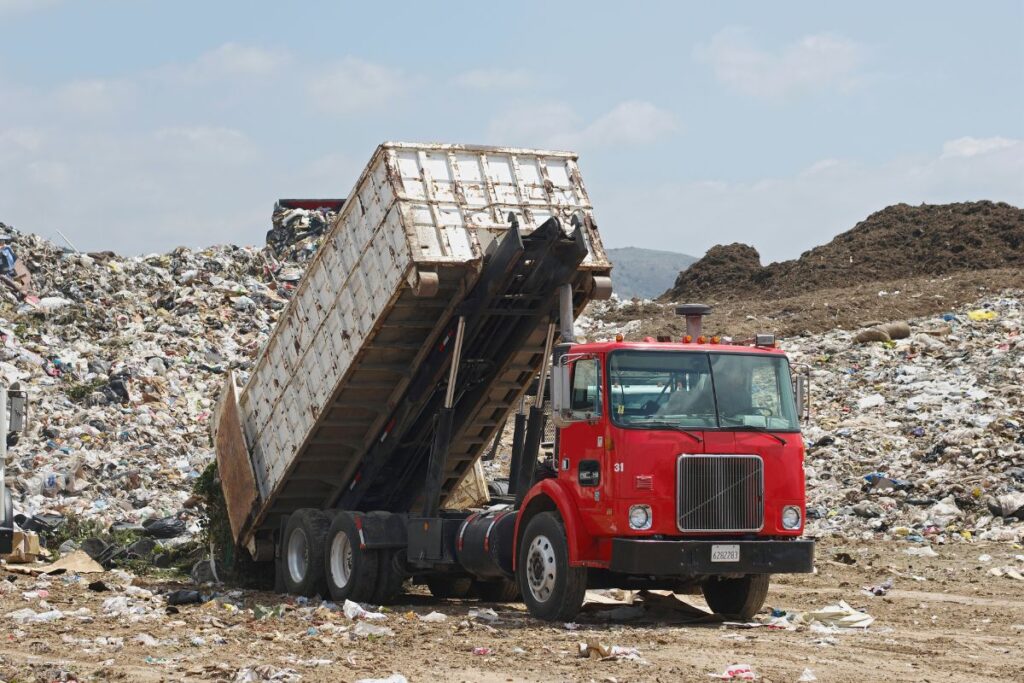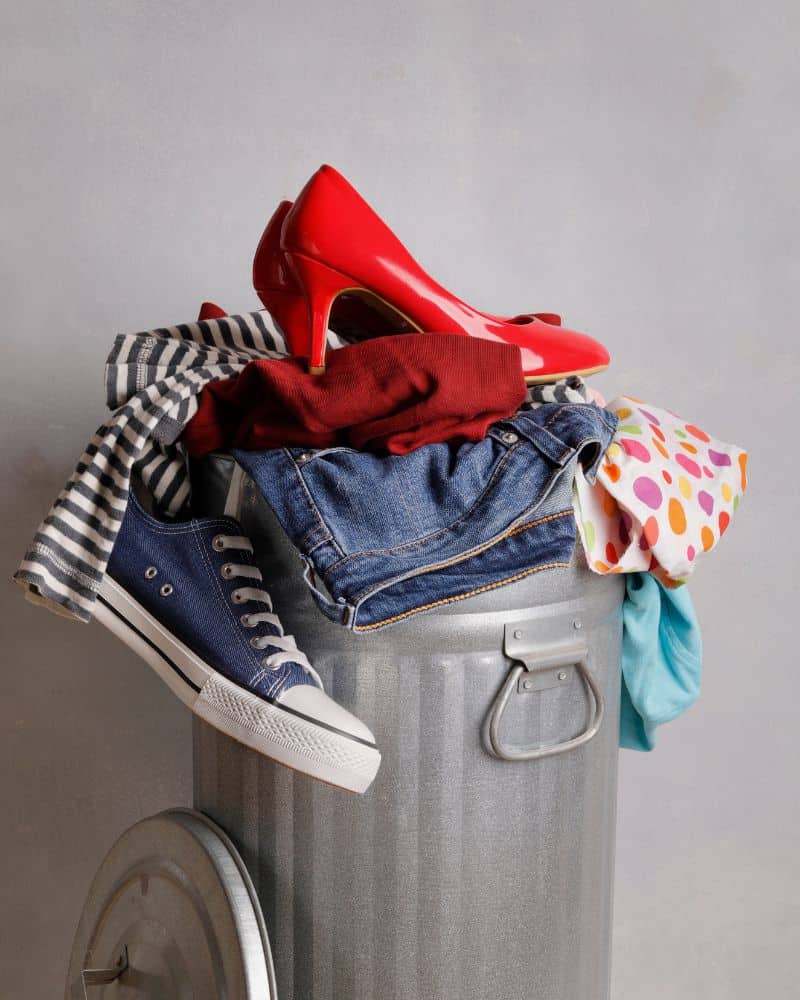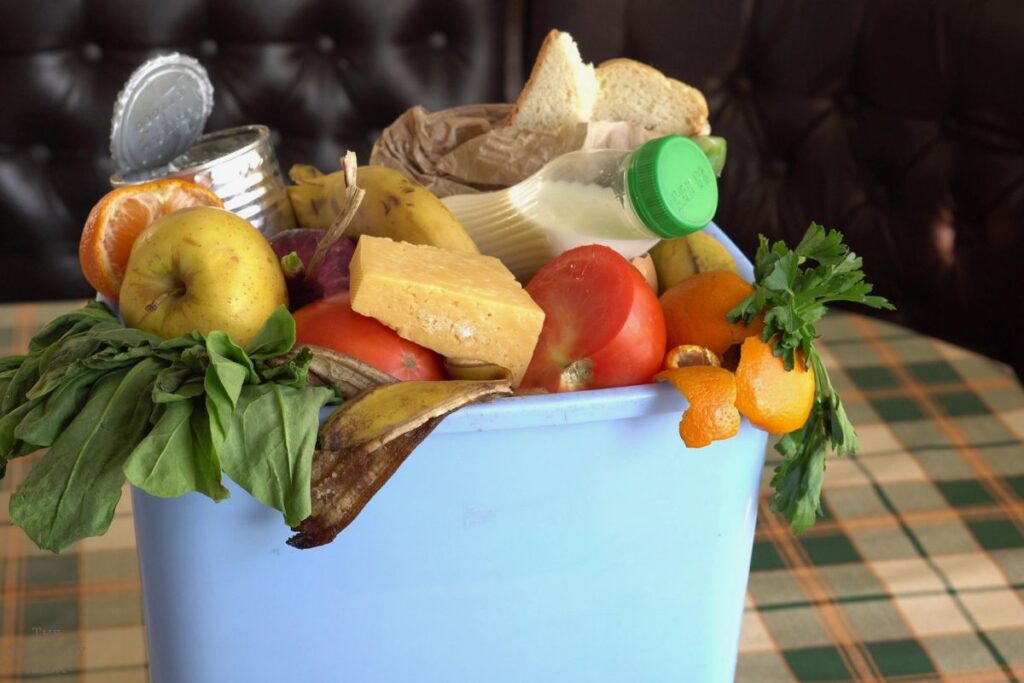Inside: This data on consumer waste may surprise you and is a motivator for considering a more minimalist lifestyle.
A guest post by Cora Gold
Minimalism is not about having all white walls and living in a sterile environment. It is about owning less but enjoying a higher quality of life.
More individuals are experiencing the benefits of this lifestyle, including more freedom, a greater sense of happiness, and lower stress levels.
Not only does minimalism have a positive impact on the individuals who practice it, but it also helps reduce waste which benefits the environment.
If you’re curious about how it can help, this data on consumer waste will reveal surprising facts that prove owning fewer things can improve your life while positively impacting the planet.

Data on Consumer Waste & Why to Consider Minimalism
If you’re considering lightening your lifestyle it’s helpful to consider the statistics on clutter to understand how big the problem of too much stuff has become.
The following data on consumer waste further demonstrates how purchasing decisions impact both your wallet and the world.
1. The Median Size of a Single-Family Home Almost Doubled in 50 Years
Fifty years ago, an American household had an average size of 3.14 people occupying a 1,500 square feet-home area. Each person has about 477 square feet of space.
In 2020, the average number of occupants shrunk to 2.53, yet the space per individual grew to 926 square feet, about the size of a large apartment.
Many Americans started to perceive their homes as luxury. Features like guest rooms, a walk-in closet, an adjoining bathroom in the primary suite, and storage areas are considered the norm. However, in many cases, a good portion of the square footage of the home doesn’t get used regularly.
A larger home likely equates to more waste. You will need multiple appliances for heating, cooling, and lighting a bigger area. Energy consumption and costs rise as does the amount of time required for upkeep on the home.
Minimalists tend to opt for simpler homes that meet their needs. They focus more on the necessities and are intentional with how they use the space in their home.

2. Two-thirds of Wealthy Americans Own a Second Home
Buying a second home is a luxury that many wealthier people consider. Some use second homes to rent out for additional income.
While it’s often considered a smart financial decision, it’s not usually necessary for the average person to own more than one home.
Having more property means buying more things to fill it. All of the stresses and expenses of maintaining a house are doubled when you buy a second home.
While some of these properties may be rented to vacationers when not in use by the owner, others sit vacant the majority of the time and merely take up space in the neighborhood.
During a time when many people are finding homeownership to be unaffordable, it can feel even more wasteful to own multiple properties that you rarely or never use.
While minimalists do tend to value travel and experiences, they also strive to be intentional with what they own to ensure that their resources are being used wisely.

3. The Average American Household Spends Nearly $1500 on Clothes Every Year
Women spend almost double than men on clothes. Several reasons point to their spending, such as they’re more likely to buy impulsively and desire to keep up with the latest trends. They’re also more inclined to purchase fast-fashion pieces made of low-quality materials. These clothes don’t last the test of time and are the first to be disposed of.
Maintaining an organized home is challenging when you own an overwhelming quantity of clothes. Plus, it contributes to clutter. A psychology professor revealed that clutter can induce stress and anxiety and harm productivity. As a result, it affects your quality of life.
Minimalists opt for quality over quantity. They have a more minimal wardrobe which makes getting ready for the morning easier.

4. People Wear a Garment Only 7 Times Before It’s Thrown Away
Fast fashion capitalizes on micro trends. Companies manufacture dresses with the latest designs and sell them cheaply to consumers. Trends change every season, cutting short the life cycle of each style.
To keep up with the changing fad, people spend hundreds of dollars on garments and wear them only seven times on average — in China, only three times — before throwing them away.
Roughly 87% of the materials used to make clothes end up in landfills, polluting the environment.
Minimalists work to be intentional with shopping. They typically approach clothes-buying carefully, intending to use them until they wear out. They try to donate clothes responsibly and recycle textiles when they can.

5. People Purchased 60% More Clothes Than They Did 20 Years Ago
People are purchasing significantly more clothes than they did years ago while keeping them for about half as long.
The fashion industry is the second-largest contributor to air pollution, with textile production releasing 1.2 billion tons of carbon dioxide every year. Consumerism is partly to blame for this.
Demand for clothes has soared, spurring manufacturers to produce more to satisfy the demand. The effect ultimately leads to environmental problems that make the earth hotter.
Clothing companies can change the industry. Ethical practices can reduce waste.
Practicing a circular model of economy that involves reusing, recycling and composting can help divert at least 90% of businesses’ waste and put them to productive use.
Minimalists invest in timeless classic pieces that you can use all year round. They’re practical and you can put their savings toward more essential spending.

6. The Textile Industry Produces 92 Tons of Waste Annually
The industry has become unsustainable at large, generating tons of waste and hundreds of gallons of dirt water that end up in rivers and oceans.
With the fast fashion segment currently valued at almost $123 billion, waste would bubble up when its worth hits $185 billion in 2027.
Experts project garment production will yield 134 million tons of waste by 2030.
Many minimalists opt to shop secondhand. They’re conscious consumers who care about where their garments come from and look for companies who care about the planet and their workers.

7. Americans Spend at Least $18,000 Annually on Things They Don’t Need
Do you need a streaming service to lead a meaningful life? No.
Entertainment expenditures that include streaming, cable, and other app subscriptions are all nonessentials that have become priorities for many people.
Advertising has shifted consumers’ perceptions of these wants and converted them into needs. Nowadays, everyone can’t seem to live without them.
Did you know you could save $24,630 per year by having a minimalist lifestyle? It’s possible by downsizing your living space, reducing your nonessentials, and opting to own fewer things.
Challenge yourself to see how much you can save in a year by living more simply.

8. An Average Household Wastes Nearly 32% of All Purchased Food
Food waste in the U.S. translates to $240 billion each year. Americans threw away a third of the food they bought, which could have saved them $1,500 worth of groceries.
Food waste occupies a quarter of the landfill space. When it decomposes, it releases greenhouse gasses that aren’t great for the environment.
Minimalism encompasses other segments of your life, including the food you consume.
By being more intentional with the food you purchase, you can reduce food waste and save yourself quite a bit of money in the process.

Minimalism Is a Lifestyle That Benefits You and the Environment
The data on consumer waste is disturbing. As more become aware of the environmental impact of their choices and what they consume, minimalism may become an increasingly popular way to live to affect positive change for those who practice it as well as the planet.
Minimalism has science-backed benefits. Owning fewer material things can reduce stress and anxiety, enhance your focus, and save you more money. There are many solid reasons to consider this lifestyle and the changes you can make to become a more conscious consumer.

Cora Gold is the Editor-in-Chief of Revivalist magazine. She loves writing about family and living life to the fullest. Follow Cora on Twitter, Facebook and Pinterest.
Were you surprised by any of the data on consumer waste? If so, share it with us in the comments section!
Sign up on the form below to get weekly decluttering and simplifying inspiration sent straight to your inbox. You’ll also get the free 8 Quick Wins for Decluttering Worksheet to help you start to simplify your life today.

